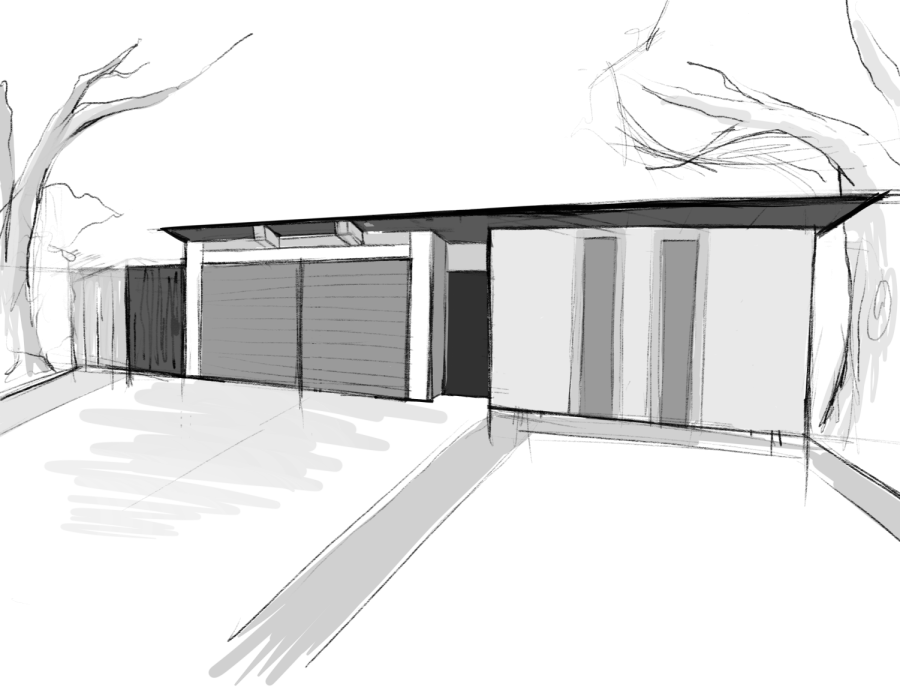An enclave of Eichlers: Palo Alto’s midcentury modern homes carry storied histories, deepen community bonds
“Carefully planned by one of the most brilliant architectural firms in the country, (Eichlers) make other homes seem obsolete by comparison,” a 1949 promotional brochure reads. “Scores of families have already learned that living in an Eichler-built home brings a whole new way of life—a life made easier, more convenient and pleasant because of the advances in modern design that are built into every Eichler home.”
This unique architecture that dominates southern Palo Alto was created by real estate developer Joseph Eichler. Though he first worked as a dairy businessman, living in a home designed by famed architect Frank Lloyd Wright inspired him to think of ways he could bring modernist home elements to the general public. In 1949, he founded Eichler �鶹��ӳ���s Inc. and partnered with various architectural firms to deliver on this objective.
Eichler �鶹��ӳ���s Inc. marketed three key priorities: design, community and affordability. These concepts are best illustrated through Palo Alto’s Greenmeadow neighborhood, an area of the city bounded by Alma Street, East Charleston Road, Middlefield Road and San Antonio Road. There, Eichler sold homes featuring open floor plans, post-and-beam construction and clerestory windows—windows located at the top of a structure’s wall. When they were first introduced to the market in 1950, the homes were sold at a modest price of $17,000. They were also in close proximity to the Greenmeadow Community Center, which housed a pool and a clubhouse to host various events. According to Greenmeadow resident junior Naya Nebriaga, the community center continues to be an integral part of the neighborhood today. “Every weekend (there’s always) something going on,” she said. “They have barbeques, wine tastings for the adults and home renovation tip sessions.”
In many aspects, Eichler’s architectural legacy has endured the test of time: Out of the 2,700 Eichler homes originally built in Palo Alto, Atria Real Estate Founder Kevin Swartz estimates that roughly 2,000 of them still remain. Some Eichler owners, such as Nebriaga, have opted to modernize their homes to make them more suitable for 21st-century living. “When we moved, we had to redo all of the plumbing and electrical and add insulation to the walls,” she said. “This past summer, we also invested in HVAC units for all of the rooms.”
While renovations are oftentimes necessary, Eichler Network Director Marty Arbunich noted their potential to detract from the classic Eichler aesthetic. “Many remodels are off the mark, and this could be attributed to one key factor: not having a clear understanding of the architecture at the onset,” he wrote in an email. While remodeling their Eichler, Nebriaga’s family recognized this risk and ensured that the new changes would complement qualities such as the interior-exterior fluidity. “When we renovated the house, we made sure that the floorings were very similar to the outside concrete area, so that it was a seamless transition,” she said.
Along with Eichler’s architectural legacy, his community ideals still pertain today, according to Swartz. “The sense of community, parades and block parties are really unique to Eichler homes,” he said. “The people who are buying and living in these homes all love their Eichlers and have a common denominator between them. It’s a great asset to the neighborhood and families, being able to participate in that.” Nebriaga also enjoys the sense of community that owning an Eichler affords her. “Our neighbor next door wants to renovate, and they’re asking us questions on what to do because renovating an Eichler is different from renovating a regular home,” she said. “If I have a friend who lives in an Eichler, it’s also really cool to see their layout, because in a way, the houses are supposed to be very similar, but each one is super different depending on what they decided to do with the interior design.”
Despite their numerous benefits, Arbunich does not foresee similar community-oriented developments being built in the future. “In the Bay Area, we’ve simply run out of space to develop new tracts of any kind,” he said. “When Eichler was building in the postwar (period), there was plenty of available land, but so much of that has been filled over the past 60 to 70 years.”
Unlike design and community, Eichler’s third ideal of affordability has fallen short of maintaining a modern-day relevance. In February, the median sale price of a home in Greenmeadow was $1.97 million, over 10 times Eichler’s original asking price adjusted for inflation. According to freelance writer Bo Crane, Eichler’s reasonable asking prices facilitated racial integration in Palo Alto. “Eichler was the first local builder to proclaim that he favored selling houses to buyers of various racial and ethnic backgrounds,” he wrote in a Palo Alto Online article published in February. “The Greenmeadow tract welcomed Eichler’s first Black homebuyers.”
Although Eichler’s socially progressive values resonate with many, the Bay Area’s low housing supply and high demand have impeded their continued application. “I’ve heard many Eichler homeowners and buyers comment on how they were aligned with the history of how he was inclusive and wasn’t discriminating,” Swartz said. “But there are a lot of people who want to live in an Eichler, and they’re looking for where they could possibly afford one. The price is definitely a big barrier.”
Nevertheless, Arbunich believes that when it comes to fostering a strong sense of community, few neighborhoods can match Eichler neighborhoods’ camaraderie and cohesion. “Eichler owners are different in that regard,” he said. “It would take a lot of education and instilling pride in home ownership to build a (similar) support network behind most other communities.”
Your donation will support the student journalists of Henry M. Gunn High School. Your contribution will allow us to purchase equipment and cover our annual website hosting costs.

Senior Chris Lee is a managing editor for �鶹��ӳ��� and has been on staff since August 2021. In his free time, Chris enjoys driving, going out for food...


